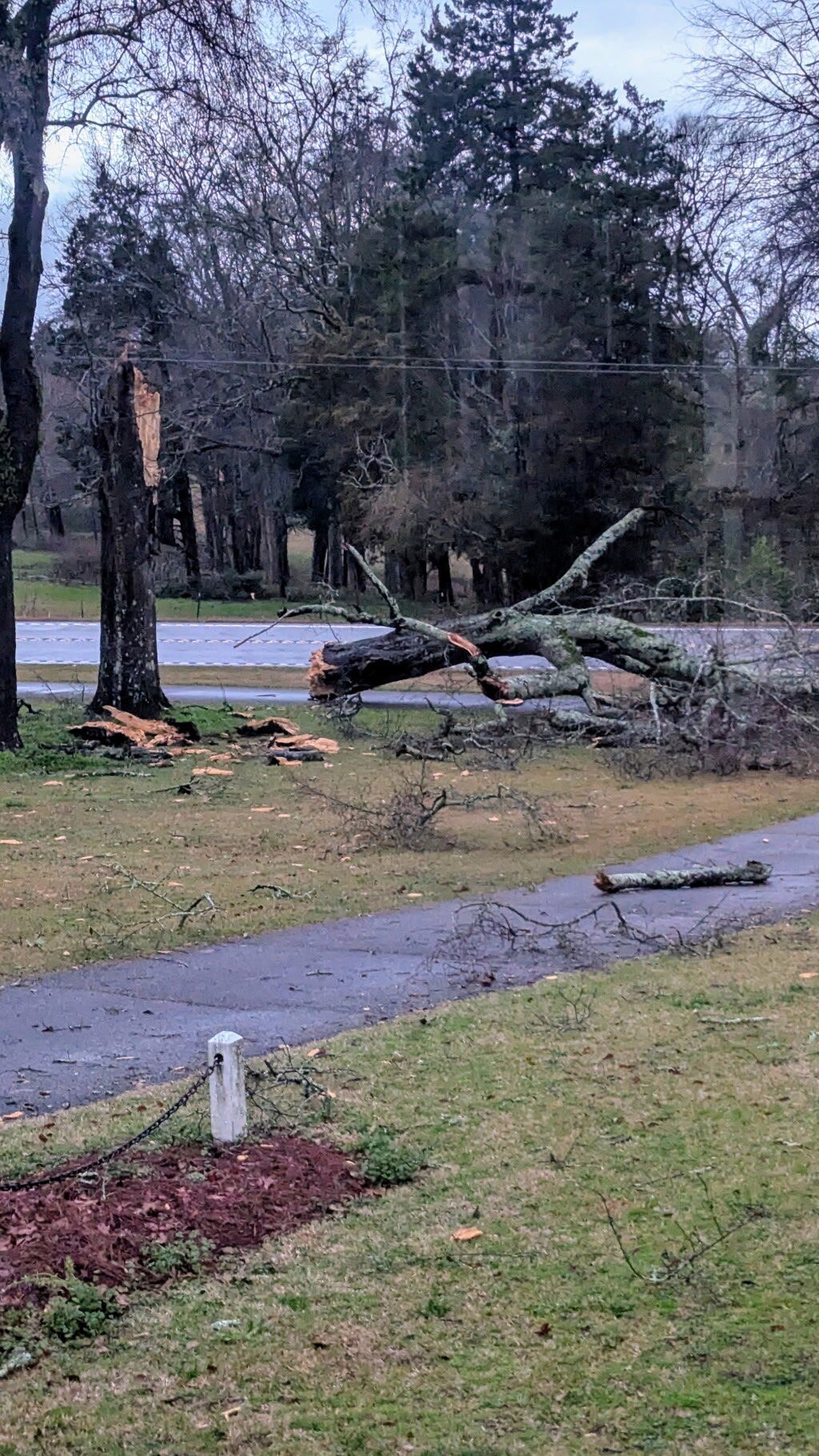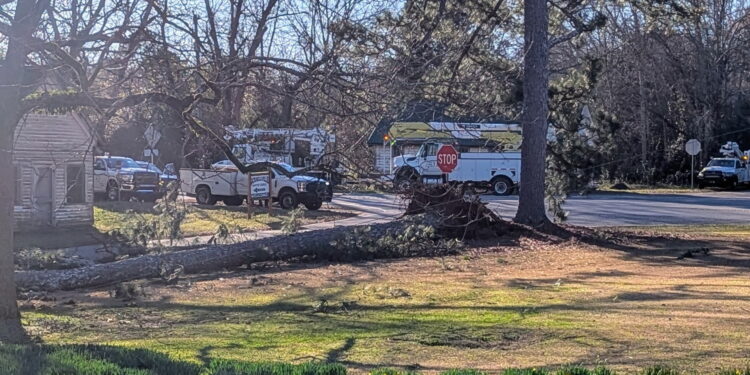By Max Nickel
On February 16, 2025, Monroe County residents experienced a period of severe thunderstorm activity coupled with a tornado warning. On February 14, Monroe County EMA warned residents of the increasing chances of an impending thunderstorm expected late Saturday into Sunday morning. They cited primarily the chance of damaging winds up to 60 miles per hour, potentially risking downed trees and power lines. At the time, the Severe Weather Risk sat at a 2 out of 5. The night of the 15th, the National Weather Service issued a tornado watch for 59 counties in Central Georgia, but the watch ultimately upgraded to a tornado warning during the early morning hours of the 16th. Captain Christina Bramlett, Public Information Officer for MCES, stated that there was no official tornado reported at any point in Monroe County.
The National Weather Service Storm Prediction Center reported numerous severe wind events throughout the county that caused downed trees and some roof damage in areas such as Culloden, Russellville, Juliette, Forsyth, Blount, and Bolingbroke. Bramlett shared she believed there were calls for downed trees from every district in the county. As of just the 16th, MCES fire crews and MCSO deputies reported clearing 27 calls and counting for downed trees in roadways and had not at the time received any reports of structural damage. “Yes, we had lots of tree-down calls,” commented Bramlett. “Thankfully, we had hardly any wires down calls, which was surprising, but there were back-to-back-to-back tree down calls.” When asked if MCES received any reports of injury, she reported that there were thankfully none.
When asked about the role of Monroe County Emergency Management versus the fire department in preparing for and responding to the severe weather situation, Bramlett explained, “Monroe County EMA serves as the liaison between the weather service and the community, as well as our fire department. We had warnings and watches to make sure that our crew stayed safe, and that they weren’t going out in the middle of a tornado, but being hunkered down until they needed to be activated on a particular call. Once the initial threat had passed and the trees down calls came, then that’s when we would have them start responding.”
Monroe resident Kristy Calhoun was one of many who experienced tree damage due to the storm. “There were trees across the road that had to be cut, and traffic was stopped in both directions along Highway 42. We had two big trees in our yard that fell across power lines,” she reported when asked about the kind of damage her property received. “They took out the power for the whole neighborhood. We had those just recently cleaned up. We had several trees on the dirt road that runs alongside our house, and you could see on the tops of the trees that they were twisted, so we feel sure there was a tornado, even though it wasn’t officially reported- you could see the tree damage, and it was like a straight line through our property. So we had the two big trees that were in our front yard, and we also had some trees along the pasture behind our house, all broken and flipped over.”
When asked if she had ever experienced the effects of severe weather like this before, Calhoun added, “I think this is the worst one I’ve ever been around. We’ve had tornado warnings before, but no, we’ve never had anything quite this bad, and we’ve never had any trees go down in the front yard like that. It was a mess.”
Calhoun was not physically there to witness the damage occur. “It was 5:30 in the morning,” she recalled. “We have a fire station that’s about a quarter mile from our house, and their tornado siren was going off. We heard the noise and some of our neighbors said that they heard what sounded like a train coming- and we don’t have a train in our neighborhood, so there were definitely loud winds, and we think it was a tornado. The siren went off several times throughout the morning so we gathered up the animals and went to the center of the house, so we didn’t see anything. It was pitch black outside but we could hear the noise of the storm and it was very windy and gusty.”
When asked about why some residents might believe there was a tornado although one was never officially confirmed, local weather expert & HAM radio broadcaster Tim Cherry offered some analysis. “The average resident reacts to their fear of the unknown. With any group of storms that come through, there’s always the possibility of having a brief spin of a tornado- it comes and goes very fast. I’m looking at how tall the storms are in height, and I didn’t see anything to indicate the average height, it was under 10,000 feet. In Lamar County, they set off the area signs in the northeastern portion of the county and said there was a tornado, but this was never confirmed by the National Weather Service. In the last 30 years, I’ve covered weather events and reported back to the NWS over the radio, and people have said they saw tornadoes, and all it was were straight-line winds.” On frequency 147.225, you can listen to Cherry broadcast over amateur radio providing National Weather Service information regarding weather and warning residents of severe weather when necessary.
13WMAZ meteorologist Ansley Parker provided some additional insight on differentiating between severe weather and actual tornados. “That warning was part of a line that had straight-line wind,” Parker said. “When the National Weather Service goes out to an area to decide whether a tornado was there or not, they look at the damage in the area and depending on the way things have blown around, what’s on the ground, the direction debris is laying, the distinction is made. With straight-line winds, all debris is going to be laying in the same direction, when you have a tornado, debris is going to be thrown about in all different directions, so it’s pretty easy to make that distinction. It probably felt like a tornado because the straight-line winds are very powerful- they can knock down the same amount of trees, they can cause the same amount of general impact.”
When asked if she thought the tornado warning worked efficiently, Calhoun shared that while her family was fortunate enough to be effectively notified, others may not have been. “We are very close to a fire station so we could hear their tornado siren going off, but some of our neighbors said they couldn’t hear any sirens,” she recollected. “So you have to have a backup, you have to be able to get the alerts on your phone. Make sure it’s not silenced overnight. When you know there might be some bad weather coming, just be aware and make sure the alerts can come in.”
Monroe County EMA reported on February 16th that many had inquired about the tornado warning system. They reported that our tornado sirens, in optimal conditions, reach 3 to 4 miles in open spaces, but that winds and rain could deeply affect their efficiency. “We really want to stress to the public that weather sirens are not meant to wake you up,” Captain Bramlett shared. “Weather sirens are not designed to alert people inside their homes. People got frustrated that they didn’t hear the sirens. There are so many factors that go into a tornado siren being audible, even outside. If the winds are blowing at 50-60-70 miles an hour, it’s shifting those sound waves in whatever direction the wind is going. It’s one layer of protection, not an end-all-be-all of notification. Having the Code Red alerts is critical, having public service alerts on your cell phone is critical, and having a weather radio is critical. The spring is the absolute highest peak for tornadoes, so now is the best time for people to be getting those weather radios, and have their safe spots designated, so in the middle of the night they don’t have to decide where they want to go to stay safe.”
Bramlett wanted to stress to the public the importance of being as effectively prepared for warnings as possible.“The trouble comes with people being asleep at night, which is why we’re so concerned when storms do come through in the middle of the night because most people are sleeping,” she stated. “This is why we encourage people to have multiple means of notification- any storm notification, but especially at night. We’re able to activate tornado sirens, but that’s for people who are outside, whereas our Code Red notifications and the National Weather Service alerts through the different weather apps are all automated through the NWS. Ideally, we really want people to have a weather radio, because that’s a good, solid source of being notified that will trigger that alarm. Code Red is a free service through Monroe County. The website is www.tinyurl.com/mcescodered, which will take you to our sign-up page. People can add multiple addresses, multiple emails, and phone numbers to be notified on.”
When asked what she would say to the residents of Monroe County as far as taking tornado warnings seriously, Calhoun said, “It can happen anytime. I would say heed the warnings when you hear the tornado sirens going off. Go to the safest part of the house. When it was happening, we really couldn’t tell anything that was happening outside because it was so dark. But I would just say be safe and heed the sirens.”







